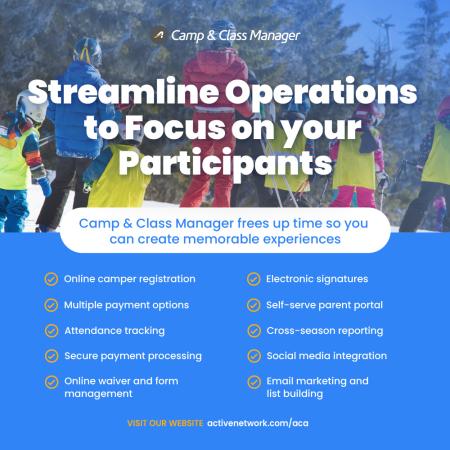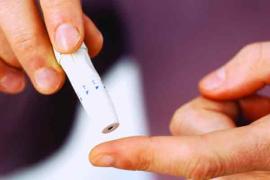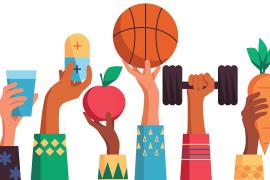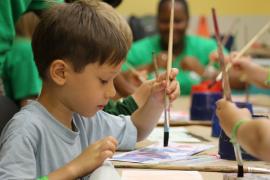Tell us a little bit about you. Did you go to camp?
I’ve been a psychologist for 20 years. But prior to that I was actually a classical musician. I was an oboist of all things. I went to a high school of the arts and then on to the Eastman School of Music in Upstate New York. So growing up I went to orchestra camps. It was a really formative part of my music education and my identity. There I was with other kids who loved classical music as much as I did, and that wasn’t necessarily the cool or common thing. I found “my people” at camp and really had access to incredible experiences that pushed me to do the best I could in a challenging field. So I feel like camps were actually a really big part of my personal story.
Among other things, you are the cofounder and chief science officer of Wise Therapeutics, where you “translate neuroscience and cognitive therapy techniques into gamified, clinically validated digital therapeutics for mental health.” That’s a mouthful. What does it mean?
We have a real problem in the mental health industry; it’s very hard to get to a therapist if you are concerned that you’re having struggles. Waitlists are often four to six months long. And antianxiety medication may be a short-term solution, but it’s really designed to be used in combination with therapy. We’ve tried to develop these digital therapeutic techniques that can help fill this gap. They’re easy to access. They’re clinically validated, so they are science, not snake oil — and they are games. These techniques are brief and very easy for individuals to use, so we can reduce stigma and help people understand that they are building their mental health rather than fixing some broken cog in the wheel. These games can be used on the go, and they’re really engaging. It doesn’t have to feel like you’re plugging your nose and swallowing medicine. We want to change how mental health is thought of and accessed.
What was your inspiration for writing Future Tense?
For 20 years I’ve worked as a researcher, focused on anxiety, emotional health, emotional risk, emotional resilience — and about five years ago, I realized that despite incredible advances in science and interventions, our mental health is worse than it’s ever been by some metrics. Certainly with our youth there is very good reason to be concerned that their mental health struggles are on the rise. So where have we gone wrong? We have the tools. We have the understanding. But we’re not keeping pace with that understanding in terms of our ability to help people.
So out of this deep sense of failure and befuddlement, I wrote this book using anxiety as a prime case study of that failure to understand what it is that’s blocking us from helping people cope and live and work with their anxiety. What’s the secret ingredient that we’re missing here?
What is the secret ingredient?
It’s our fundamental beliefs about emotions like anxiety that are difficult and what it means to be mentally healthy. We’ve come to believe that mental health equals the absence of emotional discomfort. It’s the absence of hard emotions and of struggle. So mental health has become a process of waiting until we get a disease or diagnosis, and then we eradicate it. There’s no real notion in our field that actually builds a positive state of health. Instead, we’re always working backwards, way down stream, especially with our kids, and saying, “Oh, there’s an emergency. There’s a malfunction. We have to fix it.” Now we’re in the job of destroying disease rather than building health.
I think anxiety in our society lays this problem out in big, bold letters — because everyone is or knows someone who is struggling with anxiety.
My son is one of those people who has always struggled with it, and the impulse as a parent, an educator, camp director, or counselor is to fix the anxiety and make it go away. But that won’t work as a go-to, long-term strategy. One of the most powerful things we can do is ask ourselves, “What if this anxiety is meant to be here right now? What if we’re all born anxious? What if we actually evolved to make us uncomfortable?”
If that’s the case, then what we do with it, how we think about it, and how we think about ourselves when we’re anxious (are we healthy and normal, or are we broken?) — all those things change. And if we change them in this way, I believe we will live with anxiety better. We’ll manage it better, and if we do have debilitating anxiety or a disorder, we’ll benefit more from the treatments we receive.
So we’ve been looking at anxiety all wrong?
We have this idea that emotional pain is unacceptable, that it means something is wrong with us and we’re broken. This is a mindset — a set of beliefs and responses to the emotion — that I believe is one of the causes of the rise in anxiety. Because what happens with this mindset is it primes us to do all the unhelpful things when it comes to anxiety. I describe these as the three Fs: We feel that anxiety is a danger signal, then we fear it, and then we flee from it. We believe that it should be suppressed and avoided. But when we do these things, it always amplifies anxiety. We don’t grow stronger with this impression; we grow weaker. There’s an opportunity cost — we’re not learning from the anxiety.
So this negative mindset sets us up for this vicious cycle, which will amplify anxiety over time and send us down the road toward debilitation. At the same time, it keeps us from seeing that there is a virtuous cycle of anxiety that’s possible.
It’s only by going through anxiety that we grow stronger. A virtuous cycle of anxiety — I call it the three Ls — requires us to listen to anxiety, to be with it, and acknowledge it, and see what information it has for us. Then we can leverage it. The anxiety has told us something important, and we can use it to make our lives better. Then we actually have done with anxiety what it evolved to do, and we build skills to cope. So the third L is let go. Maybe we want to go see a counselor or a spiritual advisor. Maybe exercise brings us back to the present. Maybe we share a nice cup of tea with a friend or take a walk in the woods. There are all these things we can do to let go and skills we can build.
You’ve said that over 30 percent of kids in the US will have experienced debilitating anxiety by the time they’re 18. Is it moving from normal to debilitating because we aren’t teaching kids to cope in productive ways, or is there more to it than that?
You know, to pretend that it’s just one cause would be disingenuous. It is a hard world right now. Things are fast. Things are pressured. A lot of people like to blame social media for kids’ mental health problems. I don’t do that, but I do know it’s an amplifier; there’s data to support that. What social media and our digital ecosystem is really good at is amplifying all the negatives, all the worst parts of us, all the outrage, all the shock value. It’s literally designed to do that. So put a vulnerable kid into this megaphone of negativity, and there’s a lot conspiring against them, against all of us.
We often use “anxious” and “fearful” as synonyms, but why isn’t anxiety the same as fear?
Fear is in the present, like someone has snuck into your bedroom. It’s driven by an immediate, certain threat. Anxiety is all about the future. It’s uncertain. But it can be uncertain positive possibility. That’s what makes anxiety uniquely powerful for us if we decide to make it our ally — and teach our kids and help our friends and family to do the same. If we shift our mindset to consider that possibility, we can practice getting better at embracing the virtuous cycle of anxiety.
You said that “anxiety primes us for social connection and creativity.” How does it do that?
Every emotion is information and preparation. Fear, as I mentioned, is information of certain threat and the presence of danger and preparation to freeze, fight, or flight. Anger is information that you have an obstacle block to something you want, and it prepares you to overcome the obstacle. Anxiety is also an emotion. And if we think about that, how can we look at our behaviors and our biology when we’re anxious? Again, we’re thinking about the future when we’re anxious. Something bad could happen, but something good could also happen. Let’s look at the variety of ways that our body and our mind can prepare as we’re have that feeling. When it comes to anxiety, social connection is actually a biological response that research has kind of ignored for a long time — because we didn’t even think to look for it.
The levels of oxytocin, which is the social bonding hormone, actually increase when we’re anxious. That’s the hormone that increases when you’re a mother bonding with your infant, or when you’re with a romantic partner. It makes us feel that we want to reach out to people we love. We have evolved in tribes. We know that we can outsource all kinds of needs to the tribe. So one of the best ways to manage anxiety is through social connection.
We have a tendency today to blow things out of proportion. For example, if a child is sad for a day, we might categorize them as having a problem with depression — or they might categorize themselves that way. But you’ve clearly said that anxiety and anxiety disorders are not the same. What kinds of signs should those of us who aren’t trained in psychology look for to distinguish between the two?
That’s such an important question. We don’t want to miss it when a kid is struggling. It can be a hard balance to strike, but when we think about red flags and how to identify them, we can look out for four Ds: duration, disproportion to the context, distress, and dysfunction.
You’re a kid’s camp counselor for six weeks and they’ve been sad 30 out of 30 days — that’s duration and a good first sign. But it’s not enough to just have one red flag, because maybe they say they’re sad every day but then have a great time, and they’re doing everything they need to do.
Disproportion is important because here we have to track our kids’ developmental level to the situation. Is this reaction out of proportion to what’s really happening? So they often express sadness, and it’s not because they’ve lost a competition but because their bagel was toasted on one side and not the other, and they lose it. While sadness is a normal response to challenges, if it’s disproportionate to the situation and the emotion appears to be on a hair trigger, that’s another red flag to file away.
Then, of course, the emotion needs to be distressing to the individual — and may also be distressing to others. You can imagine a scenario where a kid is angry every day, and it begins to disrupt the environment. That happens sometimes with externalizing problems. We’re mostly talking about internalizing vulnerable emotions like sadness and anxiety, but there could be a situation where the stress affects the community.
And finally there has to be dysfunction — functional impairment that is getting in the way. Maybe they’re not able to leave the cabin. They’re not able to make new friends at all. The emotion is getting in their way to a degree that goes beyond just a little bump in the road.
Just one D isn’t enough, but if multiple flags are present, that might be the time to say this child may need some counseling or other professional help. It just gives you some way of orienting. And if the child is not meeting all these criteria, maybe it’s OK that they experience the emotion. This is actually the messy work of being a kid and a human. Kids are not fragile, and we need to help them fix themselves so they can build skills to cope.
Difficult emotions do not harm people. They just don’t. What harms people is when we don’t develop the right coping skills to work with those difficult emotions.
Any other advice you would like to impart to camp professionals on the issue of anxiety?
The real take-home is all kids are born anxious. Anxiety has to feel bad to do its job. So our job as adults in their lives is to help them learn to feel anxious in the right way. It won’t harm them, and the only way we can help them feel good with the challenges and uncertainties that everyone faces in life is to help them feel those bad feelings. We can look out for the danger signs and be very tuned in and aware, but most of the time what they need is for us to abide with them in these difficult moments and help them build the skills to go through the anxiety, not around it.
This interview was conducted by Marcia Ellett, editor in chief of Camping Magazine.




